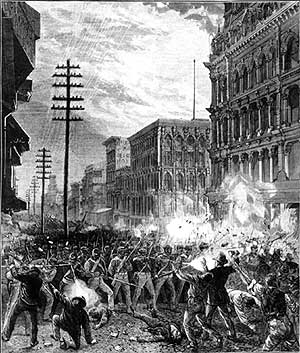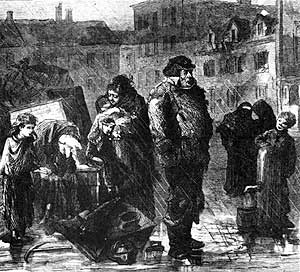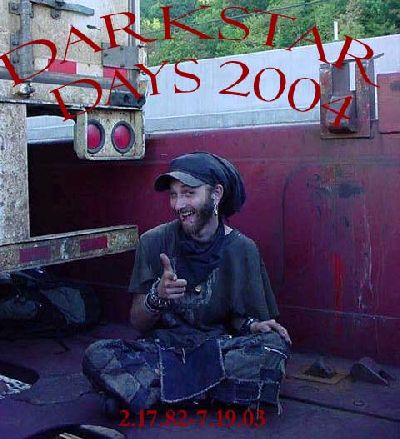Baltimore IMC : http://www.baltimoreimc.org
Announcement :: [none]
Great 1877 Railroad Strike & Darkstar Days 2004: July 18 - 21
This announcement outlines the events of Darkstar Days, July 18-21, honoring Kevin "Darkstar" Gosnell and remembering the Great Railroad Strike of 1877, which started in Baltimore and spread across the nation. The week's events include a tour of the 1877 uprising route, a teach-in, picnics, a critical mass ride, an open-mic event, memorial concert, a pot luck and more.

"The great strike--The Sixth Maryland Regiment fighting its way through Baltimore," Harper's Weekly, August 11, 1877.
In mid-July of 1877 "the most extensive...strike ever to take place in this or any other country," started at Camden Railroad Junction in Baltimore(1). One hundred and twentysix years later, in mid-July 2003, Baltimore anarchist Kevin "Darkstar" Gosnell lost his life in an automobile accident early in the morning on July 19, 2003. In recognition of Darkstar, and the Great Strike of 1877, local acitivists have organized the 1st Annual Darkstar Days, July 18- 21.
Darkstar Days 2004 Events
The events planned for Darkstar Days 2004 include a mix of global justice activism, education, socializing and entertainment. The following schedule of events have been extracted from the
"Darkstar Days 2004 website", which you might check for updates.
Sunday July 18
....* Critical Mass *
Meet in Towson at 10:30 on July 18th at the circle by Dulaney Valley Rd at "The Spot." Bring your bikes, skateboards, rollarblade etc. Please no alcohol on the ride.
....* Pyrate's Picnic *
Where: Wyman Park, 33rd and Charles St.
When: Noon-6pm
Bring food, beer, frisbees, dogs and good people.
People will be going from the Critical Mass to the Picnic, leaving at about 11am as one option.
....Critical Mass Contact: radioactivegiraffe-AT-yahoo.com
Monday July 19
Two Events: A Teach-in during the day, and a memorial concert honoring Darkstar during the evening.
....* Teach-in *
11am-5pm
Towson Library Conference Room
Workshops include: Beer making, zine making, men's discussion on patriarchy, women's discussion on sexual assualt, organizing 101, Bike 101. Information Tables will be present.
Speakers on/from: Don't Just Vote, Men Can Stop Rape, Baltimore Labor History, United Workers.
Tables Include: Brain McKenzie info shop, Pitch Black Rage, Bmore Free Store(Bring Donations), Art Not Ads (Bring Art donations)
...CLICK for More Information on the Teach-In
...Teach-in Contact: Dare-AT-ziplip.com
* MEMORIAL DARKSTAR SHOW *
When: 7pm
Where: The Shift, 106 Patapsco Ave, Brooklyn Park, MD
Bands:
The Karma Payment Plan
Torn Meniscus
Soma Solution
Azure
Pathogen/Bad Dudes
Malaise
Moon
We March
More tba.
Tuesday July 20
.... * Tour and Rally Celebrating the Baltimore Rebellion of 1877! *
4:30pm
At the 5th Regiment Armory, Howard St. & Preston St.
Mark the actions of the workers of Baltimore and the Nation over a century ago and learn about the conditions of workers currently being mistreated in Baltimore.
...Contact for Baltimore 1877 Tour & Rally: Baltimore1877-AT-ziplip.com
Wednesday July 21
... *Art Not Ads Pot Luck/Open Mic/Free Store/Art Gallery *
2pm-6pm
At 108 E. Burke Ave just south of Towson.
Bring instruments, art, food (Meat, Vegetarian, Vegan, whatever).
Synopsis of the Great Railroad Strike of 1877
"Fueled by government funds, railroad building boomed after Civil War. There were only 2,000 miles of track in 1850--by 1877 there were nearly 80,000 miles in use. Railroad owners controlled tens of thousands of employees and hundreds of millions of dollars in assets. Companies such as the Baltimore & Ohio Railroad bought coal mines, built iron mills, and consumed whole forests. Larger than some state governments, the railroads pioneered the form of the modern corporation." (2)
"From 1873 to 1878, America was struck by its first nationwide industrial depression. The depression began when railroad owner Jay Cooke was found to have issued millions of dollars of worthless stock. Investors panicked and banks closed. " (2)
During 1877, wages to rail road workers were cut several times. Baltimore & Ohio (B&O) brakemen's wages dropped from $70/month in 1873 to $30/month in 1887. (3) The Baltimore Sun wrote, "the story of their struggles to live is very sad,... Many of them declare they might as well starve without work as starve and work." (3)
Some cite the Baltimore Sun reporting as contributing to the uprising. The Sun reported on the earnings of the B&O, on July 15, 1877. B&O President Garrett reported profits to the board of directors noting that affairs were "entirely satsifactory." The board voted a 10 percent divided to stockholders. At the same time, the Sun reported 10 percent reductions in wages announced by Garrett. (3)
On July 16, the day wage cuts went into effect, the fireman on Engine 32 abandoned his train at Camden Junction (now Camden Yards), a critical point through which significant rail traffic had to pass. Other firemen followed suit, and Baltimore Mayor Latrobe ordered arrests. (3)
The strike spread down the rail lines to the West, with Martinsburg becoming "the second and more serious center of strike activity." Eventually, the strike spread to other cities including Pittsburg, Chicago, Cincinnati, and Reading. (3) The strike also included people from industries other than the rail road, and is cited as being the first general strike in the United States.

1877 Railroad Strike Reaches Chicago, IL. Police, state militia, and federal troops battled strikers in dozens of cities and towns, leaving more than a hundred dead and thousands wounded.
The Baltimore Sun reported "The singular part of the disturbance is the very active part taken by the women, who are the wives or mothers of the firemen. They looked famished and wild, and declare for starvation rather than have their people work for the reduced wages." (3)

A poor family evicted from their home. A New York City paper reported: "Thousands of men and women are to be seen nightly sleeping in our public parks. . ."
"Railroad owners called the strikers "un-American," and spoke of liberty and property rights. Newspaper editors joined the attack. The National Republican blamed the strike on "Communism--a poison introduced into our social system by European laborers." Some editors recalled the "Paris Commune" of 1871, when the workers of Paris led a city-wide revolt and set up a new government." (2)
"Yet strikers thought they were defending America's heritage of equality and independence. Pointing to government funding for railroad construction, they claimed owners had betrayed the nation's trust for the sake of higher profits. "Capital has overridden the Constitution," said one St. Louis workingman. "Capital has changed liberty into serfdom, and we must fight or die."" (2)
General William Getty led the process of crushing the strike starting in Cumberland, MD. Three days of fighting were required to open the road between Keyser and Grafton. After about sixteen days on strike, workers began returning to the job, ending the B&O strike. (3)
William Keyser, of the B&O, blamed the strikers for the "innocent men and women shot down in our streets," and for "bloodshed in Chicago and Cincinnati, Reading and other prominent cities of the land." The Martinsburg Statesman placed the blame elsewhere, noting that the uprising should teach "heartless and selfish railway corporations that there is a point in oppression beyond which it is not safe to go." (3)
Notes:
(1) The Nation, July 26, 1877.
(2) web.gc.cuny.edu/ashp/1877
(3) The Great Labor Uprising of 1877, Philip Foner.
Other References
University of Pittsburg Library
Maryland Archives: Baltimore Railroad Strike of 1877
In Memory
.
Views
Information
Search
This site made manifest by dadaIMC software


